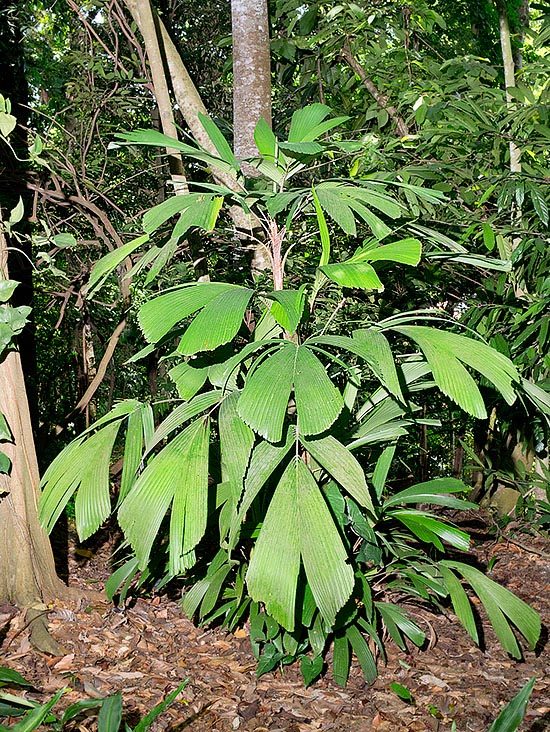Family : Arecaceae

Text © Pietro Puccio

English translation by Mario Beltramini

Reinhardtia latisecta grows in the underwood of the pluvial Central American forests © G. Mazza
The genus is honoured to the Norwegian biologist Johannes Christopher Hagemann Reinhardt (1778-1845); the specific name is the combination of the Latin substantive “latus, -eris” = side, flank and of the adjective “sectus, a, um” = cut, divided, with reference to the “windows” present in the foliar laminae on the sides of the rachis.
Common names: giant window pane palm (English).
The Reinhardtia latisecta (H.Wendl.) Burret (1932) is an unarmed monoecious species, cespitous, with erect stems up to 7-8 m tall with a diametre of 4-6 cm. The leaves, on an up to more than 50 cm petiole, are simple bifid or pennate, up to 1-1,5 m long, with pinnules grouped in 2-6 plicate laminae, up to 60 cm long and of various breadth, with toothed upper margin, divided for a short tract at the base, on the two sides of the rachis, to form a small window; the pair of apical laminae is much broader than the others.
Erect inflorescences among the leaves (interfoliar) that exceed the plant in height, ramified, on an up to about 1 m long peduncle, with 15-19 ramifications up to 20 cm long, initially cream white, then bright red in fruit, carrying unisexual flowers arranged in triads composed by two male flowers with at the centre a female one. The fruits are ovoid to ellipsoid, 1,3-1,7 cm long and of about 1 cm of diametre, of blackish purple colour when ripe, containing one seed only. It reproduces by seed, previously kept in water for two days, in draining and aerated loam maintained humid at the temperature of 26-28 °C, with germination times of 4-6 months; recourse can be done also to the division, but the divided tufts take long time to recover.
It is the tallest and most ornamental species of the genus, cultivable in open air exclusively in the tropical and subtropical climate zones characterized by constant high atmospheric humidity, where it can stand temperatures around the +2 °C only if exceptional and for very short period. It requires a semi-shaded to wholly shaded exposition and soils rich of humus, acidic or neutral, draining, maintained constantly humid.
Due to the elegance of the foliage and the relatively contained dimensions it is an excellent subject to cultivate in pot, using a loam rich of organic substance with addition of agriperlite per a 25%, for the decoration of open spaces, where and when the climate allows it, of winter gardens, verandahs and also of inner spaces, standing poorly luminous situations, with lowest temperature values preferably not under the 16 °C, taking care to increase the ambiental humidity. Useful are the fertilizations, from late spring to autumn, preferably utilizing a balanced hydrosoluble product with microelements in the form of chelates, with the frequency and the dosage suggested on the package.
Synonyms : Malortiea latisecta H.Wendl. (1853).
→ For general notions about ARECACEAE please click here.
